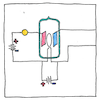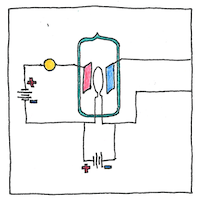Lee de Forest,
Irving Langmuir
electromagnetism

|
Triode
Audion Lee de Forest took a Fleming valve added a grid electrode between filament and plate. He left a rarified gas in the tube, believing it was necessary for electrical conduction, and wired it so a small current flowing to the grid controls a larger current flowing from the filament to the plate. Kenotron Irving Langmuir built a Fleming diode with a complete vacuum and found it could rectify higher voltages. Pliotron Irving Langmuir built an Audion with a complete vacuum and found it could amplify higher frequencies.
He said
De Forest said he didn’t copy Fleming. He said he didn’t know how the Audion worked. He said a low-pressure gas was needed, but the gas made the Audion unpredictable. He said his “spade detector” didn’t infringe on Fessenden’s electrolytic detector. He said his “sparkless” arc transmitter didn’t infringe on Valdemar Poulsen’s arc transmitter. He said he created his “ultra-audion” circuit before Edwin Howard Armstrong’s regeneration circuit. In his 1950 autobiography, de Forest said that he was the father of radio.
Radio jamming
For the 1901 International Yacht races, de Forest and two other companies—Marconi and the American Wireless Telephone and Telegraph Company—jammed each others’ transmissions because no one at the time had effective tuning. For the 1902 races, the International Wireless Company set up a transmitter to deliberately jam the other two.



Lee de Forest popularized the use of the term “radio” in place of “wireless” in the United States. In the British Commonwealth, the use of “wireless” meaning “radio” persisted longer.
See also in The book of science:
Readings in wikipedia: